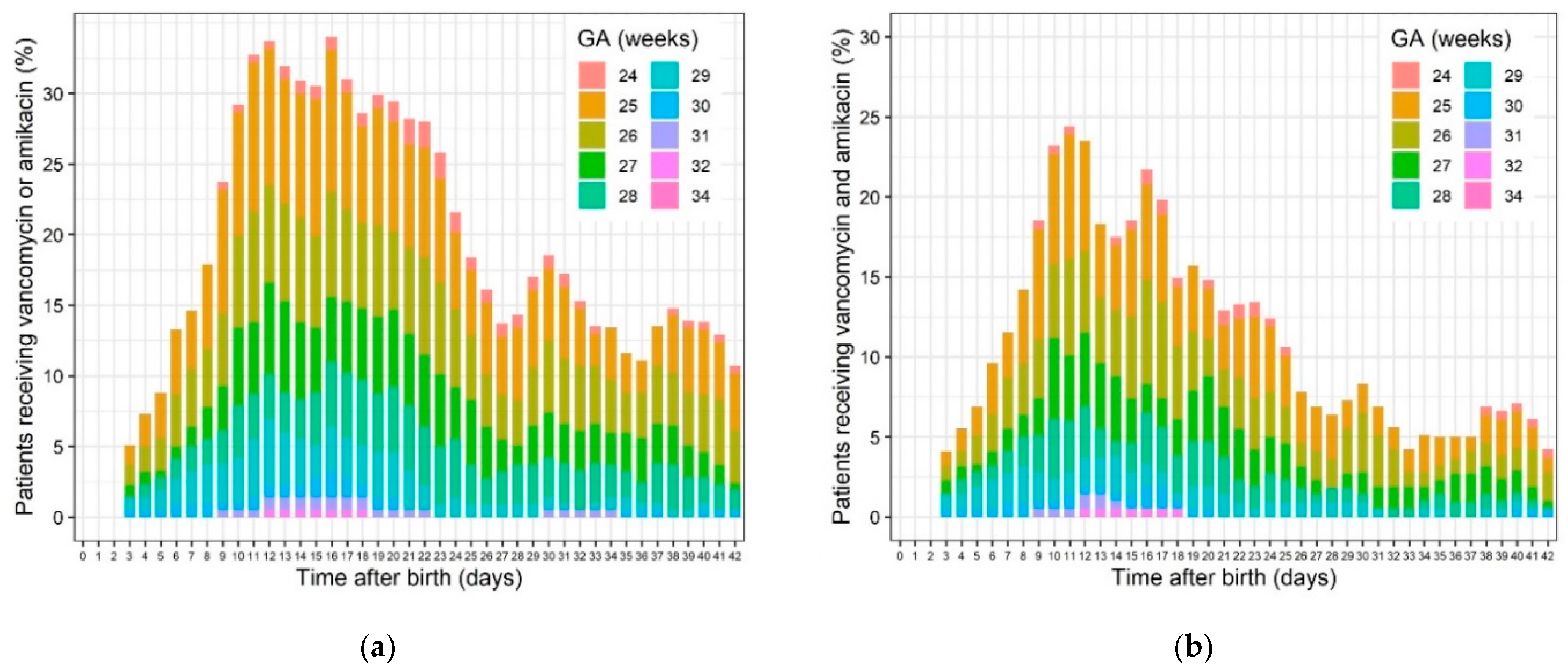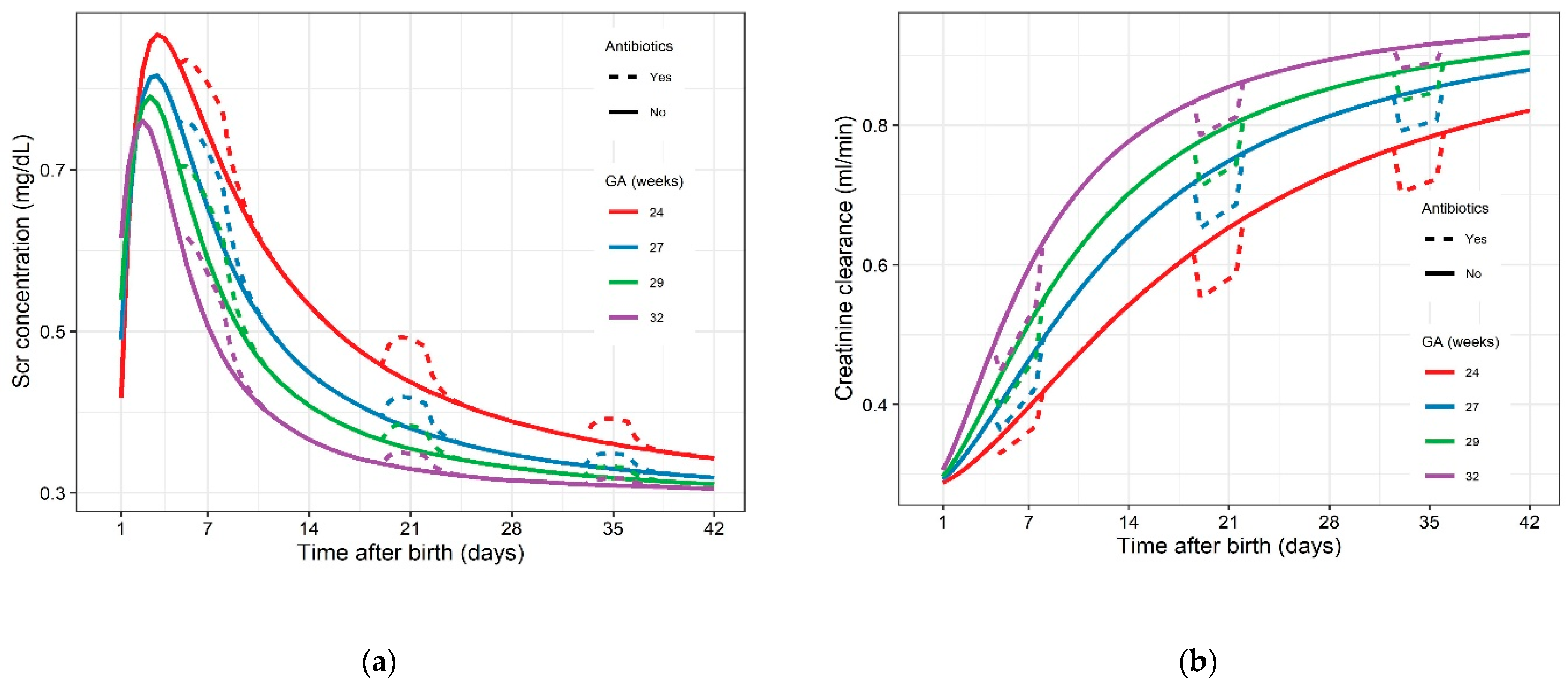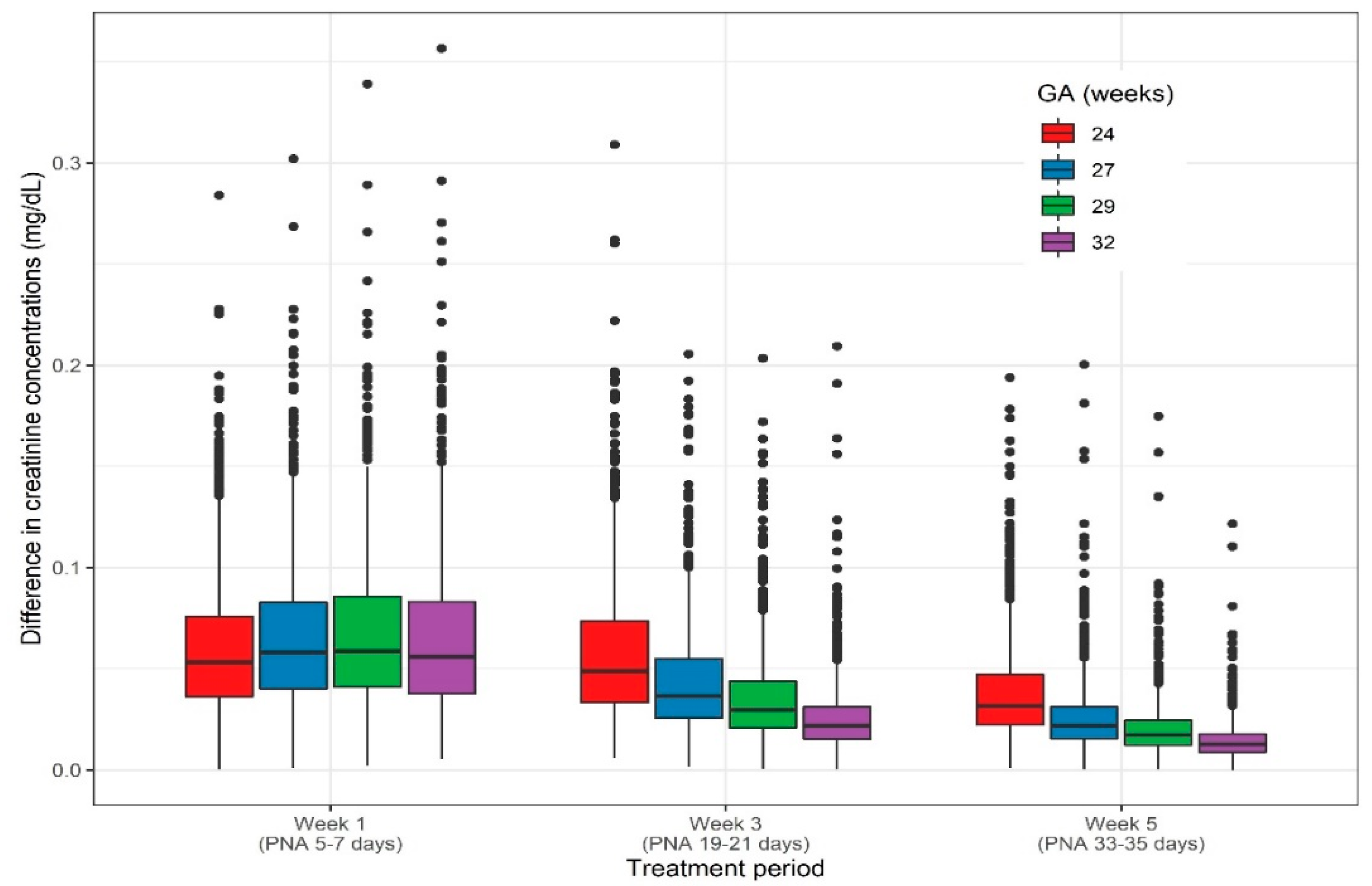Amikacin or Vancomycin Exposure Alters the Postnatal Serum Creatinine Dynamics in Extreme Low Birth Weight Neonates
Abstract
1. Introduction
1.1. How to Recognize the Signal in the Noise
1.2. Aminoglycosides and Vancomycin Related Acute Kidney Injury: Developmental Toxicology
2. Materials and Methods
2.1. Study Population, Clinical Characteristics and Ethics
2.2. Refined Serum Creatinine Model
3. Results
3.1. Population
3.2. Refined Serum Creatinine Model
4. Discussion
5. Conclusions
Author Contributions
Funding
Institutional Review Board Statement
Informed Consent Statement
Data Availability Statement
Conflicts of Interest
Appendix A
- Fixed effects: this is the population average of the model parameters θ. These parameters are susceptible to various factors, such as physiological characteristics (gestational age, body weight, etc.), genetic characteristics, or drug-drug interactions. These last factors are the fixed effect covariates, zi.
- Random effects: this is the part of the variability that is not explained by the above fixed effect and allows quantification of:
- The inter-individual variability (also called the between subject variability), which is the variability between two different individuals. It is expressed by ω2, which is the variance of the fixed effect parameter θ. For an individual i,
- The intra-individual variability (also called the residual unexplained variability), which is the variability within the same individual over time, i.e., between two given moments. It is expressed by σ2. For an observation j, the corresponding prediction ŷ for an individual is
- the fixed effect vector: θi,
- the random effect parameter quantifying the residual unknown variability: σ2,
- the random effect parameter quantifying the inter-individual variability: Ω.
References
- Davis, J.M.; Baer, G.R.; McCune, S.; Klein, A.; Sato, J.; Fabbri, L.; Mangili, A.; Short, M.A.; Tansey, S.; Mangum, B.; et al. Standardizing Safety Assessment and Reporting for Neonatal Clinical Trials. J. Pediatr. 2020, 219, 243–249.e1. [Google Scholar] [CrossRef]
- Van den Anker, J.N.; McCune, S.; Annaert, P.; Baer, G.R.; Mulugeta, Y.; Abdelrahman, R.; Wu, K.; Krudys, K.M.; Fisher, J.; Slikker, W.; et al. Approaches to Dose Finding in Neonates, Illustrating the Variability between Neonatal Drug Development Programs. Pharmaceutics 2020, 12, 685. [Google Scholar] [CrossRef] [PubMed]
- Ward, R.M.; Benjamin, D.; Barrett, J.S.; Allegaert, K.; Portman, R.; Davis, J.M.; Turner, M.A. Safety, dosing, and pharmaceutical quality for studies that evaluate medicinal products (including biological products) in neonates. Pediatr. Res. 2017, 81, 692–711. [Google Scholar] [CrossRef] [PubMed]
- Perrem, L.M.; Gosling, S.; Ravikumar, I.; Khashan, A.S.; Miletin, J.; Ryan, C.A.; Dempsey, E. Reporting on data monitoring committees in neonatal randomised controlled trials is inconsistent. Acta Paediatr. 2017, 106, 30–33. [Google Scholar] [CrossRef] [PubMed]
- Salaets, T.; Turner, M.A.; Short, M.; Ward, R.M.; Hokuto, I.; Ariagno, R.L.; Klein, A.; Beauman, S.; Wade, K.; Thomson, M.; et al. Development of a neonatal adverse event severity scale through a Delphi consensus approach. Arch. Dis. Child. 2019, 104, 1167–1173. [Google Scholar] [CrossRef]
- van Donge, T.; Allegaert, K.; Gotta, V.; Smits, A.; Levtchenko, E.; Mekahli, D.; van den Anker, J.; Pfister, M. Characterizing dynamics of serum creatinine and creatinine clearance in extremely low birth weight neonates during the first 6 weeks of life. Pediatr. Nephrol. 2020. [Google Scholar] [CrossRef]
- Charlton, J.R.; Boohaker, L.; Askenazi, D.; Brophy, P.D.; D’Angio, C.; Fuloria, M.; Gien, J.; Griffin, R.; Hingorani, S.; Ingraham, S.; et al. Incidence and Risk Factors of Early Onset Neonatal AKI. Clin. J. Am. Soc. Nephrol. 2019, 14, 184–195. [Google Scholar] [CrossRef]
- Allegaert, K.; Cossey, V.; Langhendries, J.P.; Naulaers, G.; Vanhole, C.; Devlieger, H.; Van Overmeire, B. Effects of co-administration of ibuprofen-lysine on the pharmacokinetics of amikacin in preterm infants during the first days of life. Biol. Neonate 2004, 86, 207–211. [Google Scholar] [CrossRef]
- Murphy, H.J.; Thomas, B.; Van Wyk, B.; Tierney, S.B.; Selewski, D.T.; Jetton, J.G. Nephrotoxic medications and acute kidney injury risk factors in the neonatal intensive care unit: Clinical challenges for neonatologists and nephrologists. Pediatr. Nephrol. 2020, 35, 2077–2088. [Google Scholar] [CrossRef]
- Al-Turkait, A.; Szatkowski, L.; Choonara, I.; Ojha, S. Review of Drug Utilization Studies in Neonatal Units: A Global Perspective. Int. J. Environ. Res. Public Health 2020, 17, 5669. [Google Scholar] [CrossRef]
- Smits, A.; Kulo, A.; van den Anker, J.; Allegaert, K. The amikacin research program: A stepwise approach to validate dosing regimens in neonates. Expert Opin. Drug Metab. Toxicol. 2017, 13, 157–166. [Google Scholar] [CrossRef] [PubMed]
- van Donge, T.; Pfister, M.; Bielicki, J.; Csajka, C.; Rodieux, F.; van den Anker, J.; Fuchs, A. Quantitative Analysis of Gentamicin Exposure in Neonates and Infants Calls into Question Its Current Dosing Recommendations. Antimicrob. Agents Chemother. 2018, 62, e02004-17. [Google Scholar] [CrossRef] [PubMed]
- Nestaas, E.; Bangstad, H.J.; Sandvik, L.; Wathne, K.O. Aminoglycoside extended interval dosing in neonates is safe and effective: A meta-analysis. Arch. Dis. Child. Fetal Neonatal Ed. 2005, 90, F294–F300. [Google Scholar] [CrossRef]
- Sinha Ray, A.; Haikal, A.; Hammoud, K.A.; Yu, A.S. Vancomycin and the Risk of AKI: A Systematic Review and Meta-Analysis. Clin. J. Am. Soc. Nephrol. 2016, 11, 2132–2140. [Google Scholar] [CrossRef] [PubMed]
- Filippone, E.J.; Kraft, W.K.; Farber, J.L. The Nephrotoxicity of Vancomycin. Clin. Pharmacol. Ther. 2017, 102, 459–469. [Google Scholar] [CrossRef] [PubMed]
- Lestner, J.M.; Hill, L.F.; Heath, P.T.; Sharland, M. Vancomycin toxicity in neonates: A review of the evidence. Curr. Opin. Infect. Dis. 2016, 29, 237–247. [Google Scholar] [CrossRef]
- Viel-Thériault, I.; Martin, B.; Thompson-Desormeaux, F.; Blackburn, J.; Moussa, A.; Autmizguine, J. Vancomycin drug monitoring in infants with CoNS sepsis-target attainment, microbiological response and nephrotoxicity. J. Perinatol. 2020, 40, 97–104. [Google Scholar] [CrossRef]
- Bhargava, V.; Malloy, M.; Fonseca, R. The association between vancomycin trough concentrations and acute kidney injury in the neonatal intensive care unit. BMC Pediatr. 2017, 17, 50. [Google Scholar] [CrossRef]
- Leroux, S.; Jacqz-Aigrain, E.; Biran, V.; Lopez, E.; Madeleneau, D.; Wallon, C.; Zana-Taïeb, E.; Virlouvet, A.L.; Rioualen, S.; Zhao, W. Clinical Utility and Safety of a Model-Based Patient-Tailored Dose of Vancomycin in Neonates. Antimicrob. Agents Chemother. 2016, 60, 2039–2042. [Google Scholar] [CrossRef]
- Germovsek, E.; Osborne, L.; Gunaratnam, F.; Lounis, S.A.; Busquets, F.B.; Standing, J.F.; Sinha, A.K. Development and external evaluation of a population pharmacokinetic model for continuous and intermittent administration of vancomycin in neonates and infants using prospectively collected data. J. Antimicrob. Chemother. 2019, 74, 1003–1011. [Google Scholar] [CrossRef]
- Kloprogge, F.; Hill, L.F.; Booth, J.; Klein, N.; Irwin, A.D.; Dixon, G.; Standing, J.F. Revising Pediatric Vancomycin Dosing Accounting for Nephrotoxicity in a Pharmacokinetic-Pharmacodynamic Model. Antimicrob. Agents Chemother. 2019, 63. [Google Scholar] [CrossRef]
- Nahata, M.C. Lack of nephrotoxicity in pediatric patients receiving concurrent vancomycin and aminoglycoside therapy. Chemotherapy 1987, 33, 302–304. [Google Scholar] [CrossRef] [PubMed]
- Linder, N.; Edwards, R.; MeClead, R.; Mortensen, M.E.; Walson, P.; Koren, G. Safety of vancomycin with or without gentamicin in neonates. Neonatal Netw. 1993, 12, 27–30. [Google Scholar] [PubMed]
- Jetton, J.G.; Askenazi, D.J. Update on acute kidney injury in the neonate. Curr. Opin. Pediatr. 2012, 24, 191–196. [Google Scholar] [CrossRef] [PubMed]
- Allegaert, K.; Smits, A.; Van Donge, T.; van den Anker, J.; Sarafidis, K.; Levtchenko, E.; Mekahli, D. Renal precision medicine in neonates and acute kidney injury: How to convert a cloud of creatinine observations to support clinical decisions. Front. Pediatr. 2020, 8. [Google Scholar] [CrossRef] [PubMed]
- Division of Microbiology and Infectious Diseases. Pediatric Toxicity Tables, November 2007 (Draft). Available online: http://www.niaid.nih.gov/LabsAndResources/resources/DMIDClinRsrch/Documents/dmidpedtox.pdf (accessed on 14 January 2021).
- Allegaert, K.; Anderson, B.J.; van den Anker, J.N.; Vanhaesebrouck, S.; de Zegher, F. Renal drug clearance in preterm neonates: Relation to prenatal growth. Ther. Drug Monit. 2007, 29, 284–291. [Google Scholar] [CrossRef]
- Janssen, E.J.; Välitalo, P.A.; Allegaert, K.; de Cock, R.F.; Simons, S.H.; Sherwin, C.M.; Mouton, J.W.; van den Anker, J.N.; Knibbe, C.A. Towards rational dosing algorithms for vancomycin in neonates and infants based on population pharmacokinetic modeling. Antimicrob. Agents Chemother. 2016, 60, 1013–1021. [Google Scholar] [CrossRef] [PubMed]
- van den Anker, J.; Allegaert, K. Rational Use of Antibiotics in Neonates: Still in Search of Tailored Tools. Healthcare 2019, 7, 28. [Google Scholar] [CrossRef]
- Sulemanji, M.; Vakili, K. Neonatal renal physiology. Semin. Pediatr. Surg. 2013, 22, 195–198. [Google Scholar] [CrossRef]
- Salerno, S.N.; Liao, Y.; Jackson, W.; Greenberg, R.G.; McKinzie, C.J.; McCallister, A.; Benjamin, D.K.; Laughon, M.M.; Sanderson, K.; Clark, R.H. Association between Nephrotoxic Drug Combinations and Acute Kidney Injury in the Neonatal Intensive Care Unit. J. Pediatr. 2020, 228, 213–219. [Google Scholar] [CrossRef]



| Stage | Serum Creatinine (Scr) | Urine Output |
|---|---|---|
| 0 | No change in Scr or ↑ < 0.3 mg/dL | >1 mL/kg/h |
| 1 | Scr ↑ ≥ 0.3 mg/dL within 48 h or Scr ↑ ≥ 1.5–1.9-fold change vs. Scr * within 7 days | >0.5 and ≤1 mL/kg/h |
| 2 | Scr ↑≥ 2 to 2.9 vs. reference Scr * | >0.3 and ≤0.5 mL/kg/h |
| 3 | Scr ↑≥ 3-fold change reference Scr * or Scr ≥ 2.5 mg/dL ** or dialysis | ≤0.3 mL/kg/h |
| Postnatal Age | Grade 1 | Grade 2 | Grade 3 | Grade 4 |
|---|---|---|---|---|
| <7 days | 1.0–1.7 mg/dL | 1.8–2.4 mg/dL | 2.5–3.0 mg/dL | >3 mg/dL |
| 7–60 days | 0.5–0.9 mg/dL | 1.0–1.4 mg/dL | 1.5–2.0 mg/dL | >2 mg/dL |
| 61–90 days | 0.6–0.8 mg/dL | 0.9–1.1 mg/dL | 1.2–1.5 mg/dL | >1.5 mg/dl |
| Patient Characteristics | |
|---|---|
| ELBW neonates (obs.) | 217 (4026) |
| Serum creatinine obs. per patient | 19 [14, 24] |
| Gestational age (weeks) | 27 [26, 28] |
| Birth weight (g) | 830 [720, 910] |
| Current weight (g) | 920 [790, 1130] |
| obs. per patient | 5 [4, 6] |
| Antibiotic exposure (yes) | |
| Vancomycin | 72% |
| Amikacin | 71% |
| Vancomycin or amikacin | 77% |
| Vancomycin and amikacin | 66% |
| Ibuprofen exposure (yes) | 133 (61%) |
| Mode of delivery | |
| Vaginal | 70 (32%) |
| Cesarean | 147 (68%) |
| Sex | |
| Female | 115 (53%) |
| Male | 102 (47%) |
| Neonatal death | 28 (13%) |
| Parameter (Unit) | Estimates (RSE%) | IIV (CV%) |
|---|---|---|
| Population parameters | ||
| Creabirth (mg/dL) | 0.631 (1.95%) | 0.256 (26%) |
| Kinproduction (mg/day) | 4.11 (1.07%) | - |
| CLBL (L/day) | 0.0798 (2.98%) | 0.274 (28%) |
| Emax (day-1) | 0.995 (3.87%) | - |
| t50 (days) | 22.8 (7.76%) | 0.449 (47%) |
| Hill | 1.31 (4.76%) | 0.476 (50%) |
| Covariate parameters | ||
| GA effect on Creabirth | 1.35 (21.1%) | |
| IBU effect on CLBL (no/yes) | 3.3 (1.36%)/3.23 (1.85%) | |
| GA effect on t50 | −3.09 (19%) | |
| MOD effect on t50 | −0.271 (30.3%) | |
| AB effect on t50 (yes) | 0.305 (0.91%) | |
| Residual variability | ||
| Proportional error | 0.109 (1.27%) | (11%) |
| Gestational Age | Differences in Creatinine Concentration (mg/dL) | ||
|---|---|---|---|
| Week 1 (Day 5–7) | Week 3 (Day 19–21) | Week 5 (Day 33–35) | |
| 24 weeks | 0.05 (0.04–0.08) | 0.05 (0.03–0.07) | 0.03 (0.02–0.05) |
| 27 weeks | 0.06 (0.04–0.08) | 0.04 (0.03–0.5) | 0.02 (0.02–0.03) |
| 29 weeks | 0.06 (0.04–0.09) | 0.03 (0.02–0.04) | 0.02 (0.01–0.02) |
| 32 weeks | 0.06 (0.04–0.08) | 0.02 (0.01–0.03) | 0.01 (0.01–0.01) |
Publisher’s Note: MDPI stays neutral with regard to jurisdictional claims in published maps and institutional affiliations. |
© 2021 by the authors. Licensee MDPI, Basel, Switzerland. This article is an open access article distributed under the terms and conditions of the Creative Commons Attribution (CC BY) license (http://creativecommons.org/licenses/by/4.0/).
Share and Cite
van Donge, T.; Smits, A.; van den Anker, J.; Allegaert, K. Amikacin or Vancomycin Exposure Alters the Postnatal Serum Creatinine Dynamics in Extreme Low Birth Weight Neonates. Int. J. Environ. Res. Public Health 2021, 18, 662. https://doi.org/10.3390/ijerph18020662
van Donge T, Smits A, van den Anker J, Allegaert K. Amikacin or Vancomycin Exposure Alters the Postnatal Serum Creatinine Dynamics in Extreme Low Birth Weight Neonates. International Journal of Environmental Research and Public Health. 2021; 18(2):662. https://doi.org/10.3390/ijerph18020662
Chicago/Turabian Stylevan Donge, Tamara, Anne Smits, John van den Anker, and Karel Allegaert. 2021. "Amikacin or Vancomycin Exposure Alters the Postnatal Serum Creatinine Dynamics in Extreme Low Birth Weight Neonates" International Journal of Environmental Research and Public Health 18, no. 2: 662. https://doi.org/10.3390/ijerph18020662
APA Stylevan Donge, T., Smits, A., van den Anker, J., & Allegaert, K. (2021). Amikacin or Vancomycin Exposure Alters the Postnatal Serum Creatinine Dynamics in Extreme Low Birth Weight Neonates. International Journal of Environmental Research and Public Health, 18(2), 662. https://doi.org/10.3390/ijerph18020662







